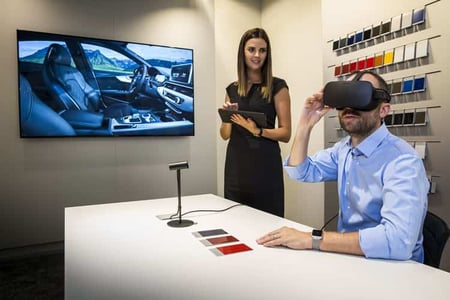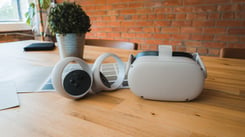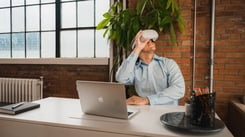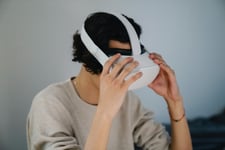Virtual Reality has been successful in delivering immersive experiences to an audience bored with brochures, catalogs, and flyers. This is increasingly important for the current generation of consumers who are content-saturated 21st century Millennial and GenZ members. The most successful companies are transitioning from material objects to experiences. As a result, businesses have started to incorporate advanced experiential technologies like VR to create a whole new way of interacting with their brand. Consequently, VR in retail is gaining significant traction - engaging customers, and driving sales.
How Could VR Enhance My Business?
1. Deepen Client Engagement. Giving customers the opportunity to connect with your products in VR allows them to envision using them in their own life and build an emotional connection with what you’re selling. This not only encourages greater brand awareness and rates of retention but makes for an overall memorable experience with your company. This could be a small but crucial step in generating trial and inserting your products into the lifestyles of your customers.
2. Try Before you Buy. In today’s market, online reviews can make or break your product - making accuracy crucial in maintaining and growing your client base. Unlike a 2D digital file, by integrating VR into your consumer-product relationship you allow potential clients to interact with the product before buying. VR consumer-product interaction removes the limitations imposed by traditional online profiles and reduces the likelihood of an unsatisfied customer. Your customers are always looking for the product that answers any barriers or inconveniences they may be facing. However, in that search, understanding a product’s specifications and qualities can be difficult when you’re not seeing it in person. Viewing the product in VR may be a simple solution to this situation. Using VR, your shopper can now pick up the product, look at it and review a pop up of all the item’s information. As a result, not only are your customer’s questions answered, but they were also able to connect with the item.
3. Make Shopping Fun Again. VR is an interactive and enjoyable medium to inform and entertain your customers. Whether you’re looking for a new way to attract prospects or to captivate those already in your store, VR offers new experiences. Enhance your customer’s experience with your brand and make shopping about more than consumption and offer experiences.
“Virtual reality is developing fast and in five to ten years it will be an integrated part of people’s lives. We see that it will play a major role in the future, for instance it could be used to enable people to try out a variety of home furnishing solutions before buying them”
Jesper Brodin, IKEA Range & Supply Manager
Virtual Reality in Retail - Use Cases
The current landscape of VR in retail is extremely diverse, and it’s especially exciting to see all the creative approaches businesses have chosen to integrate the technology into their workflow. Some of the biggest names in retail have jumped head first into the VR pool. Let’s explore how TOMS Shoes and Audi have uniquely integrated VR into their workflow.
TOMS Shoes
In recent years, TOMS Shoes released a short film called “Experience the TOMS Virtual Giving Trip”. Viewers joined the TOMS team in Peru and met some of the children that have been directly impacted by their One for One program. The film allows the viewer to enter into the experience of the distribution trip. By showing the viewer to the reality of their impact, VR allowed the viewer to emotionally connect with the companies campaign and - most importantly- their product.
This isn’t the only time that TOMS Shoes invested in a VR experience to communicate their company’s mission. The following year, they teamed up with AT&T to release “A Walk in Their Shoes”, another short film that brought the viewer to a couple of cities in Colombia. TOMS Shoes set up VR stations with the promo video in 100 of their stores, providing their customers with a brand new experience. The video reached over 700,000 views on YouTube, increasing their brand awareness and providing evidence of the impact of their mission to their current clients. TOMS Shoes founder Blake Mycoskie found the VR experience so successful that he hopes to make 5 more films in different locations to share more of their humanitarian story.
“VR is the greatest technology I’ve seen to create empathy… It’s amazing when people experience and see things first-hand. We know this because we’ve seen it when we take people on giving trips over the years. Obviously that’s not scalable, but a VR experience is infinitely scalable.”
Audi
Audi German automobile manufacturer giant Audi is a great example of personalizing VR to fit the company. Audi has primarily incorporated VR in their showrooms, allowing their customers to completely customize their car virtually. When strapped into the VR headset, customers are immersed in an extremely realistic and detailed experienced the configured car. By adding a VR element to their arsenal, dealers are now able to showcase the full line of Audi models and all the customization options with ease. In addition, the customer has the option to see their car in different environments, times of day, and light conditions.

“As part of Audi’s comprehensive initiative for digital innovation at dealerships, the VR experience is completely integrated into the brand’s IT system.”
Audi MediaCenter
Audi’s VR experience has proven to be an effective tool to help dealers communicate with their clients. Interested buyers can now configure their vehicle down to the smallest of details in VR. Previously, the most common practice of showing their line’s variety or custom options would be to flip through swatches in a pamphlet. Although this method gives an indication of what the finished product may look like, an impression of a potential product cannot be compared to the experience of reality. With VR, the client sees exactly what they will be getting. With viewing the variants in virtual reality, customers not only have the opportunity to interact with the custom product but to build confidence in their purchase. Audi has been incredibly successful in providing support and engaging with their customers by using VR.
Moving Forward
The retail industry is steadily increasing its use of advanced digital technology as the demand for an immersive purchasing experience increases. 70% of customers are interested in using VR when shopping- a statistic that suggests the expectation that VR is the future of retail. TOMS Shoes and Audi are just a few examples that have creatively and uniquely incorporated VR in retail. Whether it be creating a 360 video experience or a new and refreshing way to present your products, VR has the power to adapt into your company’s workflow where you need it. Bring back the fun in shopping, and begin to engage with your customers like never before. It’s time to give the people what they want.
Here at Yulio, we strive for excellence in performance and integrity when it comes to our product, and customer service. To learn more about how VR can enhance your business workflow, sign up for our FREE 5-day email course. For more tips and considerations on the right way to integrate VR into your business, check out our Whitepaper.


.jpg?width=245&height=150&name=active-adult-beautiful-1799244%20(1).jpg)



